Exotic Game and Feral Pig Research
Several species of exotic deer and antelope are widespread and common to large areas of the Edwards Plateau since their introduction by landowners and sportsmen. Axis, fallow, sika and aoudad, which were released or escaped confinement, are now found in major portions of Kerr, Bandera, Edwards and Real counties. Feral pigs are another invasive exotic that have drastically increased across the entire state in the last couple of decades and can have a tremendous impact on native wildlife. The Texas Parks and Wildlife Department has studied the effect of exotics on native wildlife species and native ranges. Much of this research began on the Kerr Wildlife Management Area to determine exotic food habits, habitat preference, and competition for native forage or habitat between exotic species and white-tailed deer. The Kerr WMA is currently researching population control methods for feral pigs.
Exotic Game
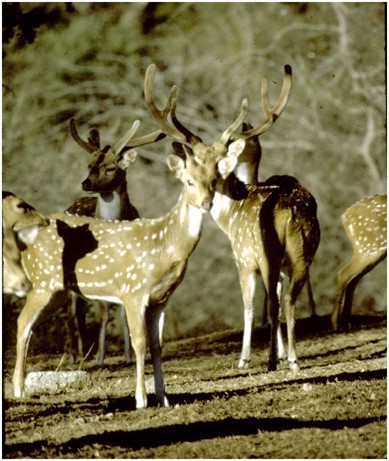
Exotic game deer.
Exotic deer were brought into the Texas Hill Country in the 1930s. Exotic numbers began to increase rapidly in the 1950s with the birth of the hunting industry. Exotic surveys by Texas Parks and Wildlife Department began in the 1960s. At that time, there were 13 species and about 13,000 animals. The last survey was in 1996. At that time, there were 190,000 animals and 76 species. According to the Exotic Wildlife Association, the 2020 estimate was 125 species making up more than 1 million animals.
Food Habits
To evaluate the impact of these exotics on native game animals, food habit studies were conducted on axis, sika, fallow deer, blackbuck antelope and aoudad on the Kerr WMA. The exotic game animals’ food habits were compared to food preferences of white-tailed deer. Observers recorded the consumption of forbs, grasses and browse by each animal species in a 96-acre enclosure over a year’s time. Researchers discovered that white-tailed deer primarily consumed forbs and browse, and that grass made up a relatively small portion of the diet. They are not capable of digesting large amounts of grass. Conversely, they discovered that while exotics will consume forbs and browse, they can and will utilize a relatively large amount of grasses. The ability to utilize all 3 classes of forage gives exotics a large competitive advantage over white-tailed deer. When forbs and browse decrease in availability then exotics can select grasses and do fine whereas a white-tailed deer cannot.
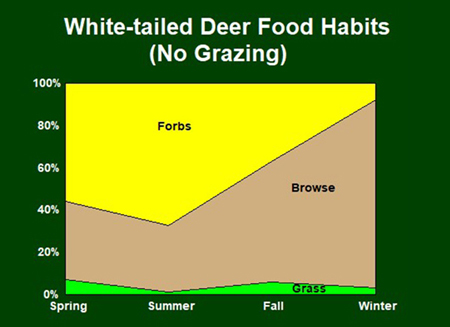
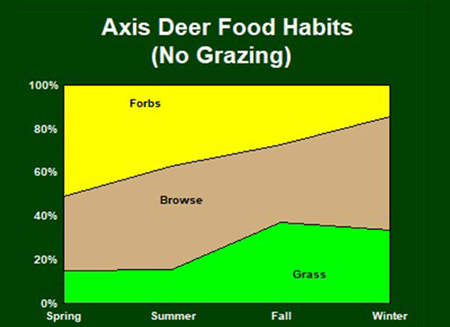
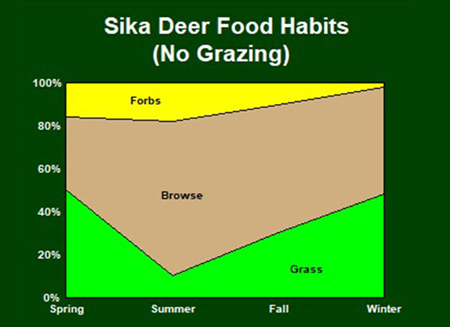
White-tailed and exotic deer food habits charts.
Competition
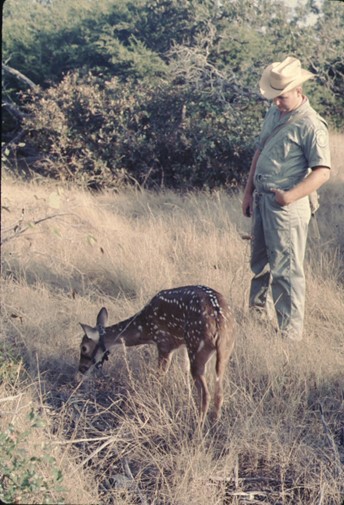
TPWD biologist monitoring
an exotic deer.
We further tested this potential competition by placing exotics and white-tailed deer together and monitoring those populations over a ten-year period. In 3 different 96 acre enclosures we placed a herd of 6 white-tailed deer (2 bucks and 4 does). One enclosure included a similar herd of 6 axis, another included a herd of 6 sika, and another held only white-tailed deer to serve as the control. In all enclosures, the populations of each species increased as expected. The exotic populations nearly tripled in the first 4 years before having die offs. By the end of the study the axis population was at 15 individuals and the sika population reached an amazing 62 animals. In both enclosures the white-tailed deer herd ultimately decreased to only 3 remaining. However, in the control enclosure, the deer population remained relatively stable with 14 animals at the end of the study.
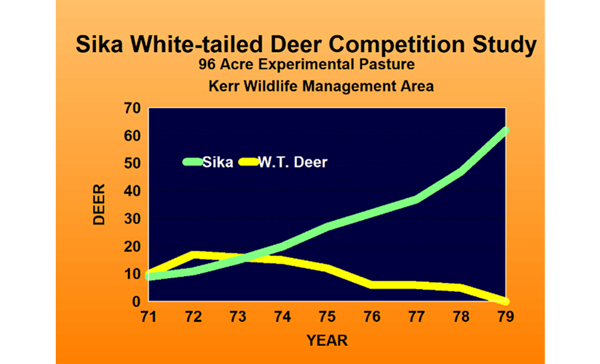
Sika and white-tailed deer competition study chart.
More information about exotic research can be found in the publication, Exotic Mammals Competing With the Natives Exotic Mammals PDF
Feral Pigs
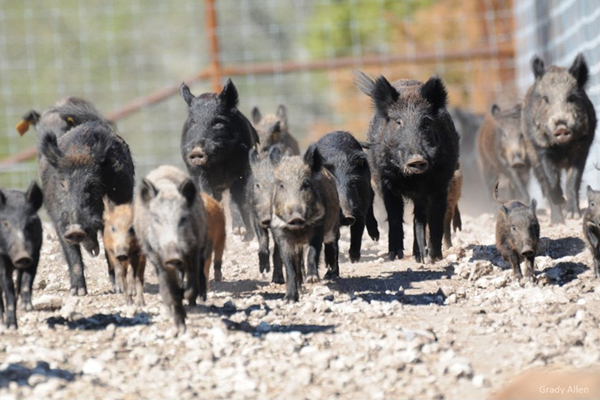
Invasive feral pigs.
Invasive feral pigs are competing with native species and damaging wildlife habitat in non-polar latitudes. For some time now, they have been increasing in abundance and expanding their range. Kerr WMA staff felt it was prudent for TPWD to help make a difference by investing in research efforts focused on population monitoring and control. Since 2009, we have been conducting investigations that contribute to the body of knowledge needed to enhance feral pig management. In addition, our work demonstrated the need for captive facilities which allow for controlled experiments and testing of new tools and techniques. Today, the Kerr WMA Feral Pig Research Facility spans 311 acres and continues to host numerous collaborations in which government, academic and private researchers conduct experiments in the name of feral pig control.
We conduct our investigations in both natural and captive settings. Each setting has pros and cons which are weighed against the types of information needed. In general, natural settings preserve normal feral pig behaviors that may be rapidly altered in a captive setting. Interaction with humans can effect behaviors of both ferals and domestics. Even feral pigs will become domesticated (again!) through frequent interaction with humans and thus may not provide behavioral data that is representative of the feral population. However, controlling important variables such as age, weight, diet or sex is more difficult in natural settings. The Kerr WMA Feral Pig Research Facility frequently affords collection of voluminous data regarding behaviors and physiology, at a faster rate than a natural setting, while controlling such variables. The facility is an excellent place to determine a feral pig’s sensitivity to poisons, diet preference or cognitive abilities. Much of the research surrounding sodium nitrite as a candidate pig toxicant were conducted in our Feral Pig Research Facility. Read on to see what we and our partners have been doing.
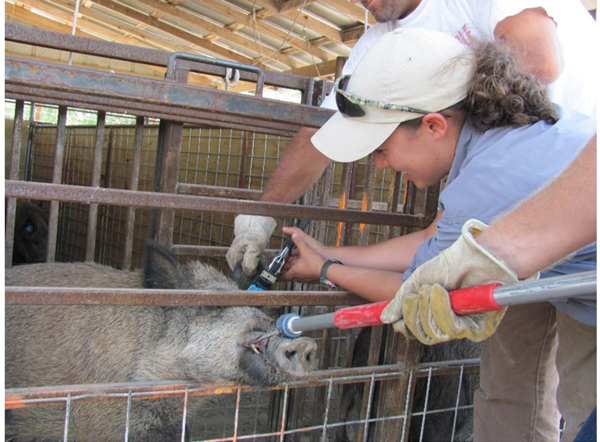
Invasive feral pig research.
Focus of Kerr Feral Pig Research
- Sensitivity of white-tailed deer, raccoons, feral pigs and turkey vultures to sodium nitrite
- Effectiveness of target-specific feeders for safe delivery of feral pig toxins
- Preference of feral pigs to prototype baits for delivering sodium nitrite
- Target specificity of bait-stations for feral pigs
- Controlled release of sodium nitrite in the feral pig
- Reducing rate of toxicants spilled by feral pigs
- Residual levels of sodium nitrite in tissues of feral pigs killed by sodium nitrite
- Which species scavenge feral pig carcasses
- Is sodium nitrite humane for feral pigs
- Effectiveness of sodium nitrite baits against feral pigs
- Best techniques for delivering sodium nitrite to feral pigs
- Deterring non-targets from consuming feral pig toxicants
- Ecology and management of feral pigs: A literature review
- Can feral pigs detect tracer dyes in baits
- Impacts of feral pigs to soils
- Alternative baits to corn for feral pigs
- How can we estimate feral pig numbers accurately and reliably
- Can carbon dioxide be used to humanely dispatch groups of feral pigs
For more information:
Ecology and Management of Wild Pigs webpage
USDA APHIS | National Wildlife Research Center: Research Areas
agrilife.org/txwildlifeservices/species-information-and-publications/mammals/feral-hogs/